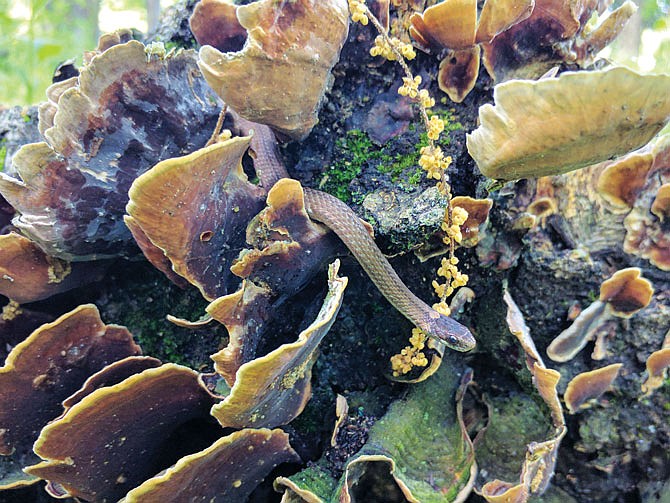With spring turning into summer, snakes are slithering everywhere.
Wildlife, including snakes, is more active in the spring, according to the Missouri Department of Conservation.
"We're in the right time of year where they're really feeding," MDC agent Stephen Kistner said. "Like many animals, they reproduce in the spring and summer."
And snakes are plentiful: Missouri is home to 41 species, though not all of them inhabit Callaway County.
However, while snakes might make your skin crawl, there's little reason to fear our scaly friends. Only five of Missouri's snakes are venomous, and all of them would prefer to avoid people, the MDC maintains. All snakes are protected by law and illegal to kill, except in cases where they're a direct threat - and a snake existing nearby doesn't count.
Identifying danger
Most snakes people encounter are nonvenomous and non-aggressive, Kistner said.
"The percentage of venomous snakes is considerably lower than the percentage of nonvenomous snakes," he said. "For the most part, snakes are not inherently aggressive. The vast majority of snake bites occur on the hand because people are trying to mess with them."
All of Missouri's venomous snakes are classed as pit vipers, according to the MDC. They have divots or holes between their nostrils and eyes, and vertical pupils.
"Venomous snakes have a blatantly triangle-shaped head," Kistner said. "That's the best way to identify them. The other ways to identify them require getting far too close."
Three out of the five native venomous snakes are rattlesnakes, easily identifiable by the rattles (actually modified scales) at the end of their tails. One of them, the prairie massassauga, is an endangered species.
The copperhead is chubby and light-colored, with large markings resembling sideways hourglasses.
The fifth venomous snake, the northern cottonmouth, is more difficult to identify. It's dark-colored with few markings and its mouth has a white lining. Missouri also has several species of nonvenomous water-dwelling snakes, all of which are protected by law.
As a rule of thumb, it's best to give all snakes you aren't familiar with a wide berth.
For help identifying a snake, check out the MDC's field guide at bit.ly/2sJXNxa.
Conflict avoidance
If you're outside and a snake is nearby, Kistner recommends simply staying away. Missouri's snakes don't perceive humans as prey and will strike only if they feel threatened. In fact, you're much more likely to be bitten when trying to confront and kill a snake than if you give it space.
"You're faster than a snake," he said. "Just walk away. It's more dangerous to attempt to kill one than it is to get away from it."
Teaching children to respect snakes' personal space is important, too, as is teaching curious dogs commands like "leave it" and "come."
Many people would prefer not having snakes on their property. The MDC has a number of recommendations for reducing the probability of snake problems.
First, don't give them cover. Snakes like to hide in heaps of trash, brush and wood, so avoid piling those near residences. The MDC also suggests keeping gardens tidy and mowing regularly.
Second, don't feed them. Many of Missouri's snakes enjoy eating rodents, while others chow down on insects. That's one of their benefits, as rodents and insects spread disease and damage crops.
"Overall, snakes are very beneficial," Kistner said. "Mice spread disease, and snakes don't."
If a property has a rodent problem, it's likely to attract snakes. If the rodent population is brought under control, the snakes will move on, the MDC said.
Occasionally, a snake may wander into a residence.
"Only reason a snake will come in the house is generally it's following food," Kistner said.
The University of Missouri Extension suggests pinning nonvenomous snakes down with a long pole such as a broom handle, then carefully scooping them up with a shovel and transporting them outside. For the snake-averse, there are services that will remove snakes, Kistner said.
"If that's not an option, that is a time I understand (killing a snake)," he said. "Glue traps will catch them."
A healthy respect
"I really would like to express that snakes are protected by the wildlife code," Kistner added. "I'd like to see them looked at as being more beneficial."
Aside from the benefits he mentioned, snakes have many interesting quirks and features.
Kingsnakes - such as the prairie and speckled kingsnake - are nonvenomous, large and easy to handle. They're among Kistner's favorites.
"I like to use them in presentations," he said.
Kingsnakes are much more fierce, however, when it comes to their prey. They eat other snakes, including venomous ones, gulping them down like wiggly spaghetti.
Hog-nosed snakes are downright charming, at least to those who like snakes. They have an upturned nose, much like a pig's. Despite being relatively small and completely harmless, they've got big personalities and impressive acting skills.
"They do a lot of weird stuff," Kistner said.
When scared, hog-nosed snakes flatten their heads and pretend to be cobras - which, of course, aren't Missouri natives. If that doesn't make the threat back off, a hog-nosed snake will roll over and play dead, excreting a stinky substance.

